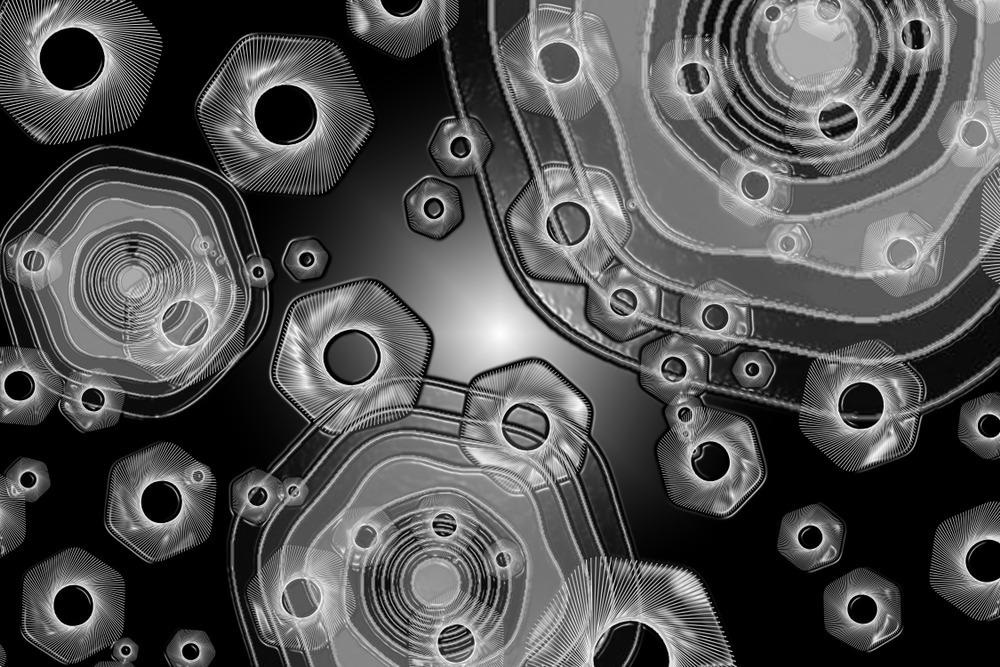A group of researchers recently published a paper in the journal Advanced Optical Materials that demonstrated the effectiveness of a novel fabrication method based on viral nano-building blocks to fabricate unconventional nano-metamaterials.

Study: Development of Unconventional Nano-Metamaterials from Viral Nano-Building Blocks. Image Credit: GiroScience/Shutterstock.com
Significance of Nano-metamaterials
Structured metamaterials are referred to periodically ordered nanostructures in which the dielectric constant can be modulated periodically on any length scale that is comparable to the operational wavelength, such as the wavelength of light. Interactions between the light wave electric fields and sub-wavelength unit structures in metamaterials can generate unusual effects that are not practically achievable in natural materials.
Nanostructures with periodicities that are similar to the wavelength of light can entrap certain colors of light. However, properly designed photonic metamaterials with periodically arranged sub-100-nanometer structures can effectively make an object invisible by guiding the light waves around the object. Photonic bandgap (PBG) metamaterials, which are another form of dielectric nanostructures, can be patterned at the sub-wavelength or wavelength scale to create a photonic bandgap that obstructs light propagation, leading to unusual effects such as negative refraction.
To develop cloaking or stealth devices, selective control and trapping of light propagation must be achieved by engineering the basic properties of electromagnetic waves, such as frequency, wavelength, and speed. Although periodic three-dimensional (3D) nanostructures are suitable for developing stealth devices, manufacturing these nanostructures with a high atomic level precision is extremely difficult. Thus, making a 3D object invisible remains a challenge.
Limitations of Existing Nano-metamaterial Fabrication Techniques
Until now, most of the photonic nano-metamaterial fabrication approaches are based on traditional lithographic techniques that are time-consuming, costly, and difficult, which necessitated the identification of novel fabrication processes to fabricate highly ordered 3D structures with sub-micrometer periodicities.
Sub-micrometer semiconductor arrays and solar cells were successfully fabricated using a general templating approach where porous templates formed through selective degradation of phase-separated self-assembled block copolymer (BCP) morphologies used to pattern inorganic materials. However, BCP morphologies are rare and their production is extremely difficult.
Importance of M13 Viral-nanostructures to Effectively Fabricate Nano-metamaterials
M13 bacteriophage chassis-based self-assembled viral nanostructures offer greater versatility compared to BCP morphologies. M13 bacteriophage can be obtained easily through bacterial fermentation and genetically and chemically modified to fabricate structures with different chemicophysical characteristics and morphologies. Additionally, M13 is suitable for the fabrication of nanostructures as it is resistant to solvents and heat.
Viral nanostructures can be assembled using several versions of M13 functionalized to interact with other materials through intermolecular interactions such as robust covalent bonds to design nanosized architectures with complex structures and functions.
Although M13-based scaffolds were evaluated to direct nanostructures for drug delivery and the nanoparticle assembly at specific molecular binding sites, the potential of M13-based quasi-3D viral nanotemplates for the fabrication of 3D nano-metamaterials has largely remained untapped.
Novel Way to Fabricate 3D Nano-metamaterials
In this study, researchers proposed a novel technique to create 3D nano-metamaterials using self-assembling M13-based viral building blocks as nanotemplates that were replicated into a metal quasi-3D nanostructure. The viral building blocks enabled the directed assembly of sub-100 nanometer materials, which were used to create quasi 3D nanoarchitectures. M13 architectures were used as nano-scaffolds to pattern metals to construct a new range of nano-network structures with desired morphologies and create innovative optical metamaterials.
Initially, several nano- and micro gratings with ridge-to-groove (R/G) ratios ranging from 0.18 to 1.0 and concentric Fresnel lens-like nanomorphologies were fabricated through focused ion beam (FIB) lithography. These were then utilized as guiding underlying topographic surfaces to fabricate different 3D nanoarchitectures from the viral nanostructures.
Subsequently, the nano-micro-structured surfaces were spin-coated controllably or submerged in the M13 solution and poly (methyl methacrylate) (PMMA)/epoxy matrix was embedded on the top of the structures, followed by the removal of scaffolds to obtain M13 assembled free-standing 3D nanomorphologies.
Quasi 3D metal viral nanostructures were fabricated by gold plating the nanomorphologies through sputtering and electrodeposition methods. These quasi-3D metal viral nanostructures possessed optical metamaterial architecture.
Atomic force microscopy, optical characterization, and scanning electron microscopy were used to characterize the fabricated 3D nano-metamaterials.
Significance of the Study
The viral nanostructures were spontaneously assembled into 3D periodic network structures. Several quasi-3D metal nano-configurations were fabricated by changing the underlying topologically structured substrates. These fabricated underlying substrates guided the M13 self-assembly and acted as topological cues for the fabrication of chiral liquid crystal (LC) phase nanomorphologies, Fresnel-like nanoarchitectures, and horizontally oriented and vertically aligned nanoviral gratings.
Several nanoviral structures displayed an improvement in hydrophobicity as the specific M13 filament orientation on underlying substrates with closely packed phage nanostructure and varying length scales of roughness restrained the droplet spread, leading to a roll-off hydrophobicity and a larger contact angle.
The plasmonic metallic/gold viral grating produced an enhanced reflection at the substrate layer, with confined induced energy emerging from localized plasmons in the gold-viral concentric rings of Fresnel-like nanostructures. The nanometer-scale ordered viral networks further facilitated the shift and modification of plasma frequency, leading to the fabrication of nano-metamaterials with distinct optical properties that are different from bulk gold.
The fabricated viral-gold nanograting-like structures demonstrated high reflection in the visible range and from the visible to near-infrared range. However, the chiral LC nanostructures and Fresnel-like viral-gold nanoarchitectures displayed a medium and lower reflection, respectively, over similar wavelengths.
To summarize, the findings of this study demonstrated that the proposed fabrication method can serve as an effective platform to fabricate and design new artificial nanostructures to create metamaterials, specifically photonic metamaterials.
Reference
White, H., Mahajan, S., Schofield, Z. et al. Development of Unconventional Nano-Metamaterials from Viral Nano-Building Blocks. Advanced Optical Materials 2022. https://doi.org/10.1002/adom.202102784
Disclaimer: The views expressed here are those of the author expressed in their private capacity and do not necessarily represent the views of AZoM.com Limited T/A AZoNetwork the owner and operator of this website. This disclaimer forms part of the Terms and conditions of use of this website.